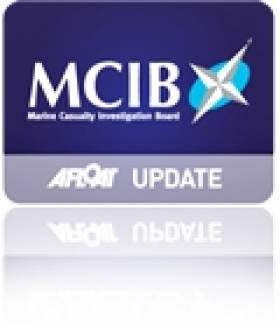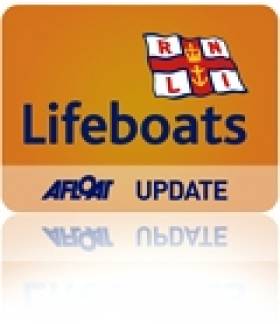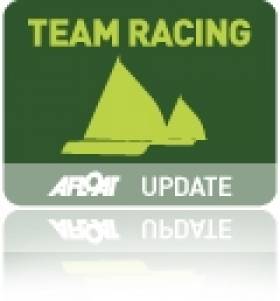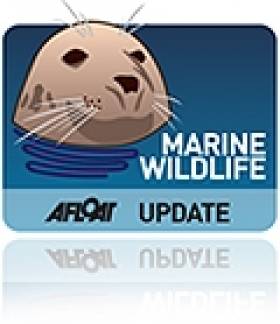Displaying items by tag: west cork
Dinghy Drowning Report Blames Poor Planning
#MCIB - Marine investigators have reiterated the importance of boaters informing people ashore of planned trips in their report into the drowning of a dinghy sailor in West Cork last autumn.
As reported last August on Afloat.ie, an afternoon sail by a father and son from the Beara Peninsula ended in tragedy after their Enterprise sailing dinghy capsized.
The body of John O'Leary from Allihies was found around 1.30am on Tuesday 14 August, just hours after he and his 18-year-son Christy had abandoned their overturned vessel to attempt the swim to shore.
The official report by the Marine Casualty Investigation Board (MCIB) found that the two had been sailing without incident in the area between Cod's Head and the Cullogh Rock for an hour or so before a gust of wind flipped their dinghy.
Unable to right the vessel, the O'Learys rested on the upturned hull to await assistance. But after many hours had passed and suspecting that the hull was starting to sink, they decided to swim to the shoreline some 800 metres away.
With 200 metres to go, John O'Leary encouraged his son to swim ahead to raise the alarm, which he did minutes later. But in the interim John went missing.
Some time into the search operation launched immediately by Castletownbere RNLI and assisted by the Irish Coast Guard from Allihies, John O'Leary's lifejacket was found in the water, and his body was located shortly after.
The MCIB report found that the Enterprise dinghy the O'Learys were sailing is of a kind notorious for its difficulty to right after capsizing. It was also noted that the craft had an insufficient buoyancy bags, which made it even more difficult to bail out once overturned.
But more importantly, the report found that John O'Leary, as skipper of the dinghy, had not arranged a return time or sailing area with anyone on shore prior to the trip.
"If he had done this, the rescue may have occurred before they decided to enter the water," the report said.
Neither man was wearing a wetsuit, exposing them to "the cold and stresses from the cold" which may have "impaired their decision making process" and prompted their decision to swim from the vessel, it added.
In its recommendations, the MCIB advises all sailors to inform a responsible person ashore of their itinerary, and to stay with their vessel as long as possible in the event of any incident on the water.
The full report into the dinghy capsize is available to download below.
RNLI Lifeboats Have Busy June Bank Holiday Weekend
#RNLI - It was a busy June bank holiday weekend around the country for RNLI lifeboats in West Cork, Mayo and the Midlands.
On Sunday afternoon, Baltimore RNLI assisted four people after their yacht got into difficulty a mile south of Mizen Head.
The 32ft yacht with four people on board had been propped by a pot buoy immobilising her in the water. The alarm was raised at 10.41am and lifeboat the Alan Massey was launched minutes later.
A local RIB, which had commenced towing, passed the tow to the lifeboat and the yacht was then taken to the safety of Crookhaven Pier.
This was the second call out this week for Baltimore RNLI. On Thursday last three men were rescued when their punt overturned near Horse Island.
Later on Sunday, Achill Island RNLI in Co Mayo brought a distressed fishing vessel with seven people on board to safety.
The volunteer lifeboat crew was requested to launch at 4.50pm to assist a small fishing vessel in the vicinity of Clew Bay and close to Clare Island. The vessel had encountered engine problems and was unable to return to port.
The boat and its crew of seven were subsequently towed safely to Curraun harbour by the Achill Island RNLI lifeboat.
Speaking after, Achill Island RNLI lifeboat operations manager Tom Honeyman said: "The presence of thick fog surrounding the vessel meant that great care was needed in the rescue and the fishing party of the vessel were delighted to return empty handed for a change."
Meanwhile in the Midlands, Lough Ree RNLI brought five people to safety in two call-outs over the weekend.
On Friday 31 May the volunteer crew was requested to launch around 5pm following a report that a cruiser had ran aground north of Quaker Island.
A local fisherman raised the alarm after spotting the cruiser on the rocks at the island located in the north end of Lough Ree raised the alarm.
The lifeboat crew managed to establish contact with the person on board the cruiser via mobile phone and he had confirmed that he had got lost and had ran aground. He reported that there was no water entering his boat. He was on his own but not injured.
The inshore lifeboat was launched and the crew was on scene at 5.30pm. It took the lifeboat 10 minutes to safely navigate its way through the rocky area to reach the casualty. The person on board the cruiser was taken to shore and arrangements were made for a specialist company to attend the scene to recover the cruiser.
Lough Ree RNLI was then launched on Sunday evening to assist a 26ft cruiser which had ran aground east of Green Island after sustaining engine failure.
The small cruiser with a family of four on board had lost engine power and had ran aground on the south east side of Lough Ree.
A crew launched the lifeboat at 8.40pm and arrived on scene 10 minutes later. After one of the lifeboat crew had carried out an assessment of the causality vessel, the decision was made to make an attempt to pull the vessel from the rocks, which the lifeboat was successfully able to complete.
Once the lifeboat had the vessel in deep water, a tow was set up and the casualty vessel was taken to Quigleys Marina in Athlone.
It marked the continuation of a dramatic week for the Lough Ree crew, after six were rescued from a sinking cruiser on the lough last Tuesday 28 May.
Tit Bonhomme Inquest Criticises 999 Service
#TitBonhomme - The "extraordinary" lack of information solicited by the operator who took the first of two emergency calls from the sinking Tit Bonhomme has been taken to task at the inquest into the loss of the trawler's crew.
The Irish Times reports that it only emerged last week that two emergency calls were made from the vessel by its youngest crew member Kevin Kershaw, though the Irish Coast Guard and the Marine Casualty Investigation Board (MCIB) were previously aware of only one.
The first - and previously unreported - 999 call from Kershaw's mobile phone at 5.46am was transferred to Bandon Garda Station rather than to the coastguard. Barrister Elizabeth O'Connel, representing the widow of skipper Michael Hayes, described the dearth of details taken by the operator on that call as "extraordinary".
It was only on the second call placed three minutes later that the Irish Guard was notified of the incident by 5.53am.
The Department of Communications has since announced it will conduct a review of the 999 service provided by the Emergency Call Answering Service (Ecas), operated by BT Ireland from Ballyshannon, Navan and Dublin.
As previously reported on Afloat.ie, five fishermen lost their lives when the trawler Tit Bonhomme went down after striking rocks at the mouth of Glandore Harbour.
The only survivor, Abdelbaky Mohamed, gave testimony to the inquest two weeks ago of his last moments aboard the stricken vessel.
Both Baltimore RNLI lifeboats responded to an emergency in the Ballydehob area last evening. The alarm was raised at 17.45 and both the all-weather and inshore Lifeboats responded immediately.
A kayaker had reported persons in the water between Horse Island and Audley cove.
The ILB helmed by Michael Cottrell was first on the scene and was directed by the kayaker towards persons in the water. Assisted by crew Gerald O Brien and Pat O Driscoll two casualties were recovered from the water.
One was a good swimmer and was keeping his friend's head above water, both desperately hanging on and near exhaustion. Pat O Driscoll entered the water to help keep the distressed casualty afloat and both were recovered to the ILB.
The ALB and Schull Lifeboat arrived on scene minutes later and both casualties were transferred to Baltimore lifeboat for first aid. The ALB made best speed to Schull Harbour where medical resources had been requested to attend.
Goleen Coastguard were at the pier to assist with landing the casualty and doctor and ambulance arrived soon after.
A 3rd survivor who had been rescued and brought to safety by the kayaker was transferred from Audley Cove by the ILB to join his friends in Schull.
Concern centered around the condition of the most distressed casualty. He was hypothermic and had swallowed a considerable amount of seawater.
The Coastguard rescue helicopter from Shannon arrived on scene, landed in adjacent playing fields and airlifted him to hospital.
None of the survivors were wearing life-jackets and all were lightly clad. Their small craft had capsized and they were attempting to swim to shore.
The evening was fine and warm but with a stiff Northerly breeze. A strong flood tide was sweeping through the sound between Horse Island and the shore.
Baltimore Lifeboat was crewed by Coxswain, Kieran Cotter, Mechanic, Sean McCarthy along with Jim Griffiths, Ger Sheehy, Ronnie Carthy, John O Flynn and Eoin Ryan
#TitBonhomme - The inquest into the Tit Bonhomme tragedy has heard testimony from the sole survivor of the incident that took the lives of five fishermen.
As The Irish Times reports, Abdelbaky Mohamed explained how he and three other crew had been asleep below deck their trawler hit Adam Island at the mouth of Glandore Harbour on the morning of 15 January 2012.
Mohamed said there was no 'big bang' when the vessel hit the rocks but it began taking on water very quickly has he, his brother Wael, Attia Shaban and Kevin Kershaw made their way to the bridge to join Saied Ali Eldin and skipper Michael Hayes.
The boat was rolling in heavy seas as Hayes handed out lifejackets to each crewmen which they then put on, he recalled, adding that conditions made it impossible for them to put on their immersion suits.
The Irish Independent has published a harrowing transcript of the crew's frantic calls to the emergency services as the Tit Bonhomme was assaulted by the waves and eventually capsized.
Mohamed said his lifejacket was ripped from his body by the force of the water crashing into the bridge, but he was able to grab onto it to reach the surface and swim towards the shore, where he was found by a search party two hours later.
Last month's report by the Marine Casualty Investigation Board (MCIB) found that crew fatigue was "the single overriding casual factor" that contributed to the tragedy, pointing out that the crew had less than five hours' sleep during their 40-hour fishing trip.
But Mohamed told the inquest that he had had sufficient rest at the time of the incident.
The Irish Times has more on the story HERE as the inquest continues.
#school team sailing – Racing in the shadow of a gale warning Schull Community College won the Irish Schools Team Racing Championships on home waters at the weekend.
14–teams competed in the event drawn Munster, Leinster, Connaught and two teams from the UK.
Reduced to a one day affair due to 30–knots winds from the south east, the hardy West Cork locals beat visitors Maudlin College (MCS) of Oxford 2-0 in the finals sailed on Saturday afternoon.
Second overall was Presentation College (PBC) in Cork.
Leinster School sailing champions Kilkenny College were third.
Teams were divided into two groups from there ranking at the regional events, with Schull 1, Rochestown College, St Andrews, Schull 2, Gonzaga, Rice College and MCS from the UK in Group 1.
PBC, Kilkenny, Belvedere, Schull 3, Scoil Mhuire, Mt Anville and Morespeed from the UK in Group 2.
Racing took place in 18 of the new team racing boats supplied for the Team Racing Worlds 2011 called the TR 3.6, with little or no breakages.
42 races were run in quick succession with the top two from each group going forward to the Semi Finals and Finals.
In the first Semi Final MCS (UK) were matched against Kilkenny College and the second Semi Final PBC were matched against Schull 1
Kilkenny and PBC matched up for the play off for Silver and Bronze, with PBC taking the Silver 2-1.
Both MCS and Schull were the winners with two wins each and went head to head for the overall result both these teams have meet each other before in two Finals over the last two years at the British Schools Team racing Nationals with one win each, so this was an important final for both teams. Schull came out the winners with two wins, putting them as favourites for the British Schools Nationals in July.
1st Schull Irish National Champions
2nd PBC
3rd Kilkenny
4th Joint/ Rochestown and Belvedere
Overseas Trophy MCS
Humpback Surprises West Cork Over St Patrick's Weekend
#MarineWildlife - A juvenile humpback whale sighting off West Cork provided a St Patrick's weekend surprise for cetacean watchers.
Irish Whale and Dolphin Group (IWDG) sightings co-ordinator Pádraig Whooley writes on the discovery made off the Stags on the afternoon of Monday 18 March, which was verified by IWDG members Simon Duggan, Youen Yacob and Robbie Murphy.
Photo ID images captured at the scene allowed experts to confirm the whale is a newcomer to Irish waters, bringing the known total to 22 and continuing a growing trend.
Whooley also notes the unusual nature of the sighting, coming some months after the busy humpback whale activity in the area previously reported on Afloat.ie.
Those whales weren't seen again after that flurry of breaching and bubble-netting off Baltimore - presumably because being an older group, they were drawn south by their migratory instinct to the tropical feeding grounds.
In contrast, this likely juvenile - named Baltimore - may have opted to winter in higher latitudes to avoid competition with bigger counterparts, something that a group of humpbacks in the Norwegian fjords have also chosen to do this year.
The IWDG has more on the story HERE.
#youth sailing – David Harte of Schull Community College Sailing Club offers his views on how one secondary school in West Cork is contributing to youth sailing and the Irish dinghy scene.
I have taken on board, with interest, many of the recent letters, forums, and discussions on the present state of dinghy racing in Ireland. Whilst generating much food for thought, I would like to avail of the opportunity to mention the very positive input, that a small secondary school situated in the far south-west, contributes to the overall status of dinghy sailing, and, racing, in Ireland.
Schull Community College has 450 enrolled students, 98% of which, would come from a non-sailing background,. The College Sailing Club has 78 members. Introduction to sailing takes place in September when all 1st year students are afforded an opportunity to experience sailing. This would take the form of a fun day out with the goal that all students come back with a smile. Those interested in learning the skills, to whatever level or standard, are invited to become members of the Schull Community College Sailing Club.
The cost for membership is €100 for the year, or €150, for two, or more, family members. This fee covers Saturday sailing throughout the year (weather permitting), with instructors and coaches, and the use of a variety of dinghies to suit all skills.
Beginners are thought the skills of sailing without reference to the SBSS (ISA Small Boat Sailing Scheme). We intentionally do not use this scheme as we have found in the past, that students prioritise attainment of levels over skills.
The goals of each student are different, with some content to sail back and forth with their friends having fun, but using the proper skills to do so, while others are eager to advance to developing Team Racing skills. Progress to this stage can be achieved once the student has demonstrated a good understanding of the 5E's, and can sail around a course with little or no rudder. Saturday sailing, during the year, attracts an average of 30 sailors on a cold day to 50+ on a sunny day Team racing discipline is used at the school as it is an achievable goal with little or no personal resources required, with boats and coach supplied by the FMOEC.
"We intentionally do not use the ISA Small Boat Sailing Scheme as we have found in the past, that students prioritise attainment of levels over skills".
Students learn the advanced skills of sailing, an introduction to racing rules, and team work. A typical Saturday would involve, briefing, boat handling exercises, team racing, and de-briefing, as well as boat maintenance, and seamanship skills, etc. With team racing, students upskill rapidly, as competition for team places is continuous throughout the year. Most of the students would never have sailed outside of Schull Harbour, but, within a few years, clearly demonstrate a skill level, equal to, or above their peers from other clubs. When students reach transition year they have an extra days sailing on Wednesdays. At this stage students are divided into two groups, with one group learning to sail and the other learning the skills required to become a Dinghy Instructor. For instructorship, students attend VHF, First Aid, and Powerboat courses, and their pre-entry. At this stage, none of the students would have any SBSS levels, but, they would have the skills necessary to pass their pre-entry Most of these courses are subsidised by the FMOEC which allows the student to become an Instructor, without the burden of recourse to personal resources. Mainstream costs to fulfill all courses required to become an Instructor approximate in the region of €1,500, which, in my view, is completely ridiculous.
Most of the students who become instructors, are offered summer jobs at the centre, teaching the SBSS to the general public. Our courses run for nine weeks, and it is during this that our instructors see the downfall of the SBSS, with a sizeable percentage of students attending the courses showing more interest in the cert., rather than the skill. This in turn forces sailing clubs and centres to issue certs., as parents believe they have paid for the cert., and not the skills. Our team racing teams participate in many events throughout the year, ranging from the Munster Schools Team Racing Championships to the International Wilson Trophy.
A look at the results from last years 1st team, which consisted of six team members, of which, five came from a non-sailing background, demonstrates the achievement of the FMOEC syllabus. Irish National Champions, British U21 Champions British Schools Champions, Youth Helmsman Champion, Silver Senior Helmsman Championships, 4.7 National Champion and Silver Radial Championships. It would be easy to ascribe this success to 'an exceptional team', but, Schull teams have been Irish National Champions every year, except two, have won the British Schools Championships four times, and been in the top four over the last six years.
One may pose the question....'where do they go after they finish at Schull Community College, and, do they continue sailing?..... Follow up on team-racing participants, whether they go on to 3rd. level, or, otherwise, demonstrates a continuing healthy involvement in sailing activities. In 2011 the ITRA (Irish Team Racing Championships) were held in Schull and over 50% of the helms entered in the event were ex-Schull Community College.
In conclusion, it is my belief that the present state of dinghy racing in Schull (Ireland) is strong, and, demonstrably, getting stronger.
More on this subject of dinghy sailing here
New Solo Challenge Across The Celtic Sea
#Solo - Elaine Bunting writes on her Yachting World blog about this summer's Jester Baltimore Challenge, a spin-off of the solo transatlantic Jester Challenge for small boats.
The new event is much smaller in scale, with a route across the Celtic Sea from Plymouth (or Pwllheli in Wales) to Baltimore in West Cork starting on Sunday 16 June.
But that's intended with low cost of entry in mind - there are no fees to pay - to attract small boat sailors who've yet to test themselves in a solo challenge.
Yachting World has more on the story HERE.
Man and Child Drowned Off West Cork
#News - TheJournal.ie is reporting news of the tragic drowning of a man and a young child off West Cork in the early hours of this morning (6 March).
The bodies of the man and the three-year-old girl were recovered by emergency teams after the Goleen unit of the Irish Coast Guard was tasked to the area following a missing person's report.
Coastguard volunteers found the child on the beach but attempts to resuscitate her were unsuccessful. The body of the man was later discovered in the shallows by the Baltimore RNLI lifeboat.
It's being suspected that the man and the young child entered the water.
TheJournal.ie has more on the story HERE.






































































